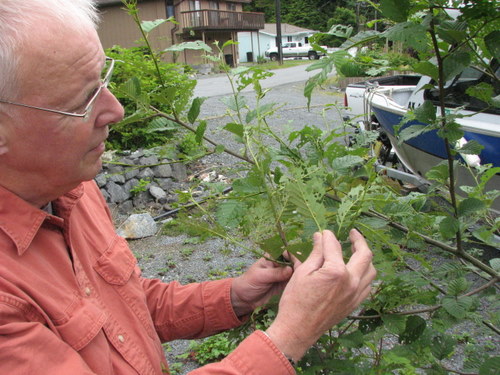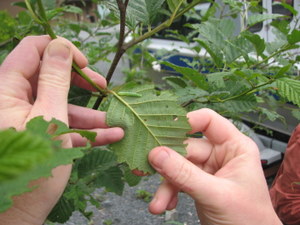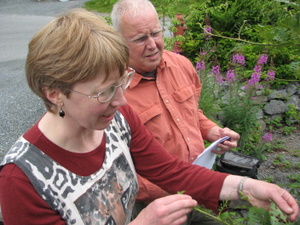
Cooperative Extension agent Bob Gorman assesses the damage to a small alder. (KCAW photo/Robert Woolsey)
A Forest Service entomologist is fairly certain that the bright green caterpillar which recently defoliated a small tree in a Sitka neighborhood is the green alder sawfly.
Samples of the insect are headed to a sawfly expert at the Smithsonian Institution for confirmation, but in the meantime, area residents should pay attention to what may be living on — and eating — local alder trees.
It’s a pretty common call to any radio station newsroom around here: Somebody’s found something unusual, it might be — fill in the blank — Japanese tsunami debris, Jimmy Hoffa, or a bright green caterpillar from North Africa.
Well this time, fans of Detroit’s most enduring mystery will be disappointed, but those concerned about unusual insects will not.
“I’d like to think that this was the only tree, but I’d say the chances of it just being here and nowhere else in Sitka are not big.”
Bob Gorman is the Cooperative Extension Agent in Sitka. We’re standing in a yard on Shelikov St., looking at the green alder sawfly.
 “It’s a little more than an inch long, maybe a sixteenth of an inch wide. It’s really light green, with sort of a darker stripe green. The head is about the same color as the body.”
“It’s a little more than an inch long, maybe a sixteenth of an inch wide. It’s really light green, with sort of a darker stripe green. The head is about the same color as the body.”
There is a native sawfly that feeds on alder, but this damage is far more extensive. The leaf Gorman holds has been devoured with remarkable precision. It looks like lace.
“You see this kind of defoliation where there’re these little holes. That’s not that uncommon. But these guys are just skeletonizing the leaves.”

Sitkan (and assembly member) Michelle Putz noticed that a small alder in her yard had been devoured when she came home from a recent vacation. (KCAW photo/Robert Woolsey)
“When you have a new introduction, the best thing you can do is treat it quickly, before they spread and become established. If, say, the only place we find them is this one neighborhood, then we really want to try to nip it in the bud and make sure they don’t spread into the forest. Once that happens, it’s difficult — almost impossible — to manage.”
The green alder sawfly is native to North Africa and Southern Europe. It was first found in eastern Canada in the 1990’s, and identified in Alaska in 2004. The green alder sawfly has been found in Oregon and Washington, and it’s become a major problem in some drainages around Anchorage — Ship Creek and Campbell Creek in particular.
Read a US Forest Service publication on the green alder sawfly.
We’ll never know how it got to Sitka. We just know it did not get here by itself.
“It could have been on a barge. It could have been in somebody’s car when it was on the ferry. That’s one of the great mysteries. It very well could have come from Anchorage.”
The green alder sawfly eats in summertime in caterpillar form, molts several times, and then drops to the ground in fall. It overwinters in soil or dead wood, and emerges in spring as an adult sawfly, which resembles a small wasp.
It’s at this stage that some form of pesticide, or other biological control, might be introduced to contain the sawfly. Graham says she’ll be back next spring to survey the amount of airborne sawflies, and to determine how far it has spread.
Alder are a major part of the forest ecosytem in Southeast. The fast-growing trees fix nitrogen in the soil, provide shade along stream banks, and shelter young conifers. Widespread defoliation would be a major disruption, but would it be a disaster?
“The environment is good at adapting. And even though this is something new that’s been introduced, I think that there will be ways to catch up.”
Graham says the beetles common in Southeast will make a nice meal of sawfly larvae. So will the birds. In fact, as I stand next to the devoured alder on Shelikov St., a small bird — maybe the aptly-named alder flycatcher — darts in and pays back one of the caterpillars in kind.
KCAW – Got another!
Gorman – That’s the control we need right there.”































